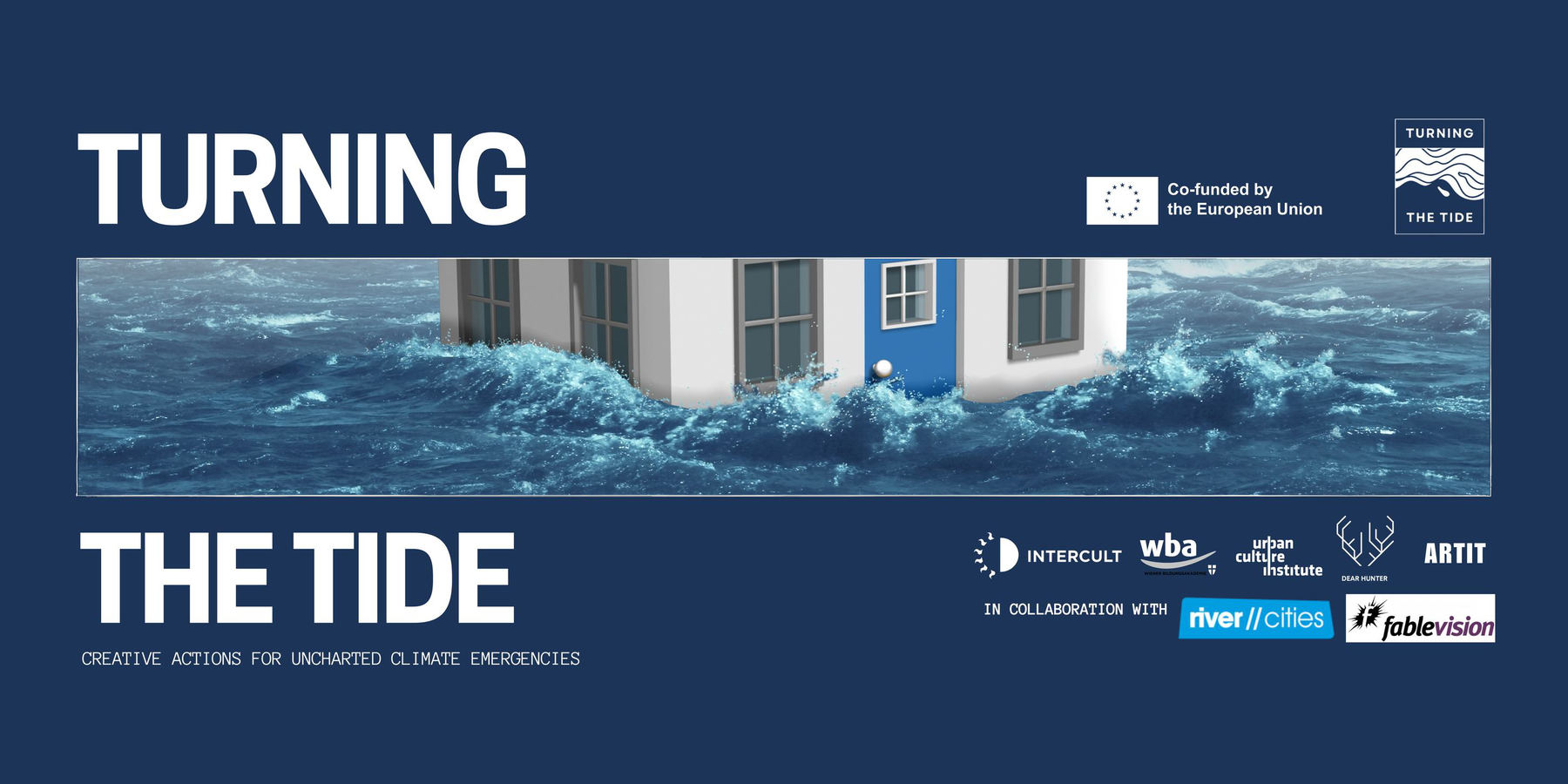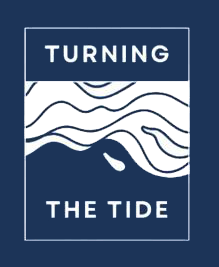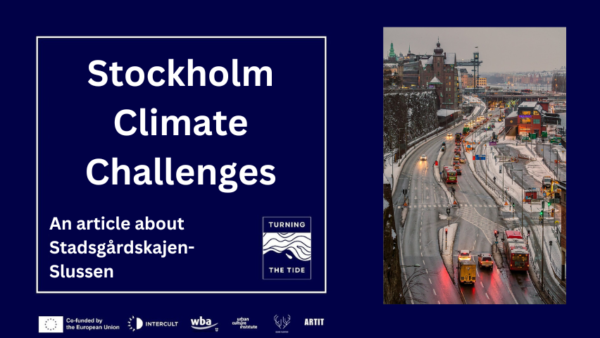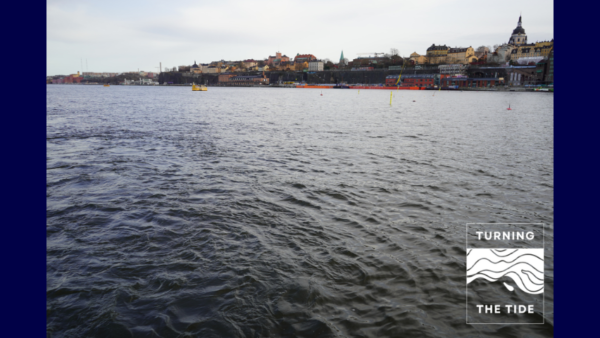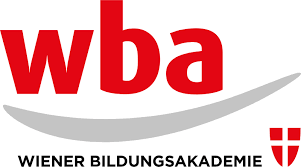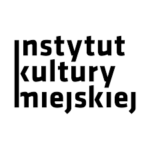Turning The Tide
Turning the Tide (TTT) is a transformative European cooperation project, co-funded by Creative Europe, dedicated to exploring and addressing the pressing issue of climate change through the lens of artistic and cultural practices. Our project spans across four European cities, each facing unique challenges related to climate change, particularly in waterfront zones. We are a collaboration of diverse organizations and experts from various fields, united by a commitment to creating impactful and sustainable change through creative and cultural interventions.
Our mission is to harness the power of art and culture as dynamic forces in addressing climate change and fostering sustainable communities. We envision a world where artistic expression and cultural engagement are central to understanding and tackling environmental challenges. Our project aims to empower local communities, amplify diverse voices, and foster innovative solutions to the problems posed by climate change, with a focus on waterfront communities uniquely affected by these global issues.
TTT is an ambitious artistic intervention and a transdisciplinary dialogue. We aim to engage local residents, amplify unheard voices and raise awareness of climate issues in waterfront cities. Through a collaborative effort in four cities, TTT uses a cultural planning methodology and works with socially engaged artists to lead an international experiment that explores the potential contributions of artists and local communities, residents to the climate change narrative, and explores climate justice.
The TTT project includes 5 partner countries – Intercult (Sweden), Artit (Greece), Vienna Education Academy (Austria), DEAR HUNTER (Netherlands) and the Urban Culture Institute (Poland) in collaboration with Fablevision (Scotland) and the River//Cities Network.
Visit the Turning The Tide website
for upcoming events, webinars and open calls!
03 April 2024
This article discusses the impacts of climate change and urbanisation on drinking water in Stockholm in general and the environment of the Slussen-Stadsgårdskajen area in particular. Our starting point is the body of water defining Stockholm – Lake Mälaren.
Mälaren is a freshwater lake and the main regional source of drinking water. About 2 million people currently rely on Mälaren for water, and the number is likely to increase as the population of the Stockholm region is expected to grow to 3 million by 2040.
There are three main environmental factors affecting the future situation of drinking water quality and access in Stockholm. These factors are interconnected, may influence each other and have similar causes.
- Saltwater contamination from rising sea levels
- Flooding
- ”Brownification” and fertiliser spill from agriculture, as well as pollution from industry and urbanisation.
The following impacts on the local climate of Stockholm are predicted to arise from climate change caused by human activity:
- Increased yearly rainfall
- Prolonged droughts
- Rising water levels
- Warmer, drier summers
- Shorter, wetter winters
- More frequent freezing-thawing cycles
Together, these changes lead to increased unreliability of freshwater and drinking water access for individuals, agriculture and industry.
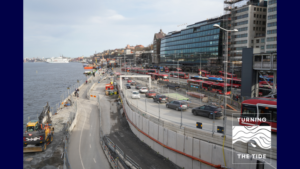 Saltwater contamination
Saltwater contamination
Today Mälaren empties itself into the Baltic Sea. The water level of Mälaren has been artificially regulated since 1946, and currently sits about 0.7 metres above sea level. This is a rather small difference, and it leaves Stockholm water processing plants with diminishing room for extracting drinking water as the sea levels rise. If the difference becomes 0 or negative, saltwater from the Baltic will flood into Mälaren.
The lakeflow is regulated by several floodgates in Stockholm and Södertälje. The new floodgates at Slussen in central Stockholm are expected to be able to manage a sea level rise of 1 metre. This is expected to prevent flooding and saltwater from entering Mälaren until the end of this century. After 2100, the sea levels will be too high and another solution is needed. Stockholm is not currently facing collective short term risks in the access to drinking water from Mälaren, but if extensive countermeasures are not taken, in the coming century this freshwater source may be permanently compromised as the rising Baltic Sea threatens to turn Mälaren into a saltwater bay.
There are three different proposed solutions to this threat:
- Continually raising the level of Mälaren as the sea rises. This will prevent saltwater contamination, but large areas of land will be submerged or at an increased risk of flooding.
- Constructing large barriers and floodgates across the archipelago. This would create a large dam of fresh or mildly saline water protecting Mälaren and surrounding land from rising sea levels. Similar projects have been constructed in London, the Netherlands and St Petersburg. This would mean that all boat traffic in and out of Stockholm must pass through a floodgate. Large pump facilities would also be needed to regulate the water in case of Mälaren flooding, and to prevent stagnant wastewater collecting.
- Finding an alternative water source. The river Dalälven and the lake Vättern have been suggested. This would mean constructing a 150-200 km long tunnel, together with pipes, man made lakes acting as reserves, and other supporting infrastructure. The sediments of Dalälven may also contain high levels of heavy metals from the mining industry, which require additional processing.
In addition to Mälaren, many residences and farms in the Stockholm region have independent water sources, mainly in the form of groundwater. These already face problems with saltwater contamination during long periods with no rain, when the groundwater level drops below sea level.
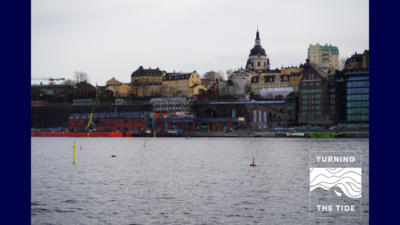 Flooding
Flooding
Waterways, lakes, sea and rainfall can all pose flooding threats. Mälaren is currently at a low risk of extreme flooding, thanks to the new floodgates at Slussen. In addition, the land in the Stockholm region is still rising after being suppressed during the latest ice age, which will mediate the rising sea levels during the period 2000-2050. During 2050-2100 the sea rise will most likely exceed the land rise.
In the meantime, excess rainfall and urbanisation can increase the risk of floods. Stockholm is expanding rapidly in the form of new housing, businesses and industries. This leads to a larger percentage of ground being covered by tarmac or concrete. Many waterfronts are fortified in similar ways. This makes the land less capable of absorbing excess water, leading to increased, faster drainage into waterways and increased flooding risk. According to SMHI the drainage into waterways and lakes will increase up to 75% during winter. Flooding can also lead to contamination of emergency freshwater reserves.
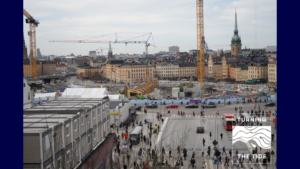 Brownification and pollution
Brownification and pollution
Warmer sea temperatures and a surplus of fertiliser runoff from farmland are leading to increased algae blooms and “brownification” of the water in Mälaren, which will put more demands on water processing plants. Heat and drought might cause temporary demands for drinking water from people and agriculture that surpass what the plants are able to produce.
Increased yearly rainfall, higher water levels and more frequent shifts between freezing and thawing cause increased risk of soil erosion along waterlines. Landslides and soil erosion contribute to the problem of brownification, as increased topsoil movement can transport contaminated soil across great distances, and increased rainfall can hasten the soil erosion of farmland and cause a greater amount of fertiliser to be flushed into both Mälaren and the Baltic. This causes large algae blooms, which leads to a large amount of dead organic matter falling to the seafloor. There the decomposition uses up most of the available oxygen, leading to oxygen-deprived seafloors with little life other than anaerobic bacteria, which do not require oxygen.
Urban development is also an important factor in ground stability, as it can remove trees and vegetation which would otherwise stabilise the earth in slopes and other sensitive areas.
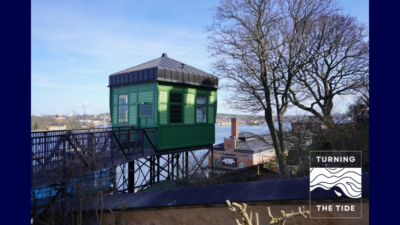 The past and present cultural heritage of Slussen and Stadsgårdskajen
The past and present cultural heritage of Slussen and Stadsgårdskajen
The history of Slussen dates back centuries, with its first lock, Queen Christina’s Lock, constructed in 1642. Over time, it has undergone several renovations to address evolving traffic needs. The current redevelopment efforts, led by Norman Foster’s firm, aim to modernise the area while preserving its historical essence. Slussen plays a crucial role as a barrier between saltwater and freshwater in Stockholm. Additionally, it serves as a pivotal connection point between Södermalm and Gamla stan, both by water and land. The metro station at Slussen acts as a major transportation hub, facilitating travel across the city and beyond.
Stadsgården, situated between Slussen and Masthamnen, has transformed significantly over time. While remnants of its industrial past still linger, the area now grapples with congestion, pollution, and ongoing construction. Despite efforts to preserve cultural heritage, the bustling motorway and bus terminal dominate the landscape, making it less pedestrian-friendly. Today Stadsgården is a flat area dominated by asphalt, concrete and building construction sites. It is bordered by the water on one side and by the steep cliff walls of the rest of Södermalm on the other. It is connected to Södermalm via elevators and stairs up the cliffside, as well as tapering out elevation-wise to the east.
Stadsgården embodies a blend of historical significance and contemporary challenges. The area is home to cultural institutions like the Stadsgårdsterminalen venue and Fotografiska (museum of photography) which contribute to its vibrancy. However, the constant flow of traffic and limited pedestrian space create a dichotomy between its cultural appeal and practical accessibility.
The evolving landscape of Stadsgården raises questions about its identity and future trajectory. While efforts are made to balance progress with heritage preservation, the area’s designation as a cultural environment underscores the need for sustainable development that honours its past while embracing future possibilities.
Historical sites and venues of Stadsgården
- Stadsgårdsterminalen, which was the departure point for ferries to various destinations in the Baltic region, now houses the homonym cultural events centre.
- Nya Tullhuset, the customs building established in the 20th century for taxing imported goods, was transformed into Fotografiska in 2010. It now serves as a venue for national and international photographic exhibitions that change periodically.
- The old electric elevator called Stadsgårdhissen, built in 1907, provided an easier way to reach the harbour area from the higher part of the Södermalm quarter, specifically in Slussen. The elevator has since been decommissioned and repurposed for art exhibitions by private initiative.
- The building Drottsgården, constructed in 1909 but damaged in the 1970s, was eventually demolished by the municipality.
Writers: Hanna Granlund, Elisavet Papageorgiou
Sources:
“Framtidens vattentillgång i Mälaren, Göta älv, Bolmen, Vombsjön och Gavleån Underlag till Dricksvattenutredningen”, Eklund, Anna, Axén Mårtensson, Jenny, Bergström, Sten, Sjökvist, Elin. SMHI, Samhälle och Säkerhet, Affärsverksamhet, https://www.diva-portal.org/smash/record.jsf?pid=diva2:927111
“Heritagisation process in an urban area: The case of Stockholm’s harbour, Stadsgården, during the 20th century in relation with the present”, Stefano Vilardi, Stockholm University 2023, https://www.diva-portal.org/smash/record.jsf?pid=diva2:1772989
“Mälaren om 100 år”, Länsstyrelserna, https://miljobarometern.stockholm.se/content/docs/tema/klimat/Malaren/Lst-Malaren-om-100-ar-rapport-2011.pdf
“Remiss-Regional handlingsplan för klimatanpassning i Stockholms län”, Länsstyrelsen, https://www.lansstyrelsen.se/download/18.3581480b18b37f787ba87cc/1697632221671/Tillg%C3%A4nglighetsanpassad%20Remiss%20Regional%20handlingsplan%20f%C3%B6r%20klimatanpassning%20Stockholms%20l%C3%A4n%20PB.pdf
Vision 2040 Stockholm – City of Opportunities, Stockholms stad, https://start.stockholm/globalassets/start/om-stockholms-stad/politik-och-demokrati/styrdokument/vision-2040-mojligheternas-stockholm.pdf

Disclaimer
FUNDED BY THE EUROPEAN UNION. VIEWS AND OPINIONS EXPRESSED ARE HOWEVER THOSE OF THE AUTHOR(S) ONLY AND DO NOT NECESSARILY REFLECT THOSE OF THE EUROPEAN UNION OR CREATIVE EUROPE. NEITHER THE EUROPEAN UNION NOR THE GRANTING AUTHORITY CAN BE HELD RESPONSIBLE FOR THEM.
